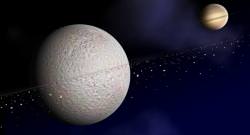Saturn is known for the spectacular rings that circle the planet, and the Cassini spacecraft has been exploring Saturn’s rings, as well as its moons since 2004. And now Cassini has found evidence that there may be rings around one of Saturn’s moons, too: Rhea, the second largest moon in Saturn’s system. This is the first time rings may have been found around a moon. While no images yet have been taken of the rings (the picture here is an artist’s rendering) an extensive debris disk and at least one ring appear to have been detected by a suite of six instruments on Cassini specifically designed to study the atmospheres and particles around Saturn and its moons.
“Until now, only planets were known to have rings, but now Rhea seems to have some family ties to its ringed parent Saturn,” said Geraint Jones, a Cassini scientist and lead author on a paper that appears in the March 7 issue of the journal Science.
Rhea is about 1,500 kilometers (950 miles) in diameter. The apparent debris disk measures several thousand miles from end to end. The particles that make up the disk and any embedded rings probably range from the size of small pebbles to boulders. An additional dust cloud may extend up to 5,900 kilometers (3,000 miles) from the moon’s center, almost eight times the radius of Rhea.
Since the discovery, Cassini scientists have done simulations to determine if Rhea can maintain rings. The models show that Rhea’s gravity field, in combination with its orbit around Saturn, could allow rings that form to remain in place for a very long time. The discovery was a result of a Cassini close flyby of Rhea in November 2005.
One possible explanation for these rings is that they are remnants from an asteroid or comet collision in Rhea’s distant past. Such a collision may have pitched large quantities of gas and solid particles around Rhea. Once the gas dissipated, all that remained were the ring particles. Other moons of Saturn, such as Mimas, show evidence of a catastrophic collision that almost tore the moon apart.
“The diversity in our solar system never fails to amaze us,” said Candy Hansen, Cassini scientist and co-author on the paper. “Many years ago we thought Saturn was the only planet with rings. Now we may have a moon of Saturn that is a miniature version of its even more elaborately decorated parent.”
Original News Source: JPL/Cassini Press Release


Amazing. The more we look, the more we know we don’t know.
Did anybody predict this? Considering how much junk there is around Saturn, it seems obvious in retrospect.
Amazing. It is. This is the sort of thing I can imagine when I’m staring into the sky at night. When I think of what’s out there, I feel so small. Think about how small a speck of dust is in this universe! Amazing.
Look forward to hearing more.
-geniusgirl_123
KissKiss!
Fantastic! After Ida, it seemed moons containing moons became almost common place in our solar system. Can it be too long before we discover binary moons or the moons of moons with their own little satellites? Enceladus is still freaking everyone out. I say throw the rule book out when it comes to small celestial bodies.
Great to see there’s still stuff in the immediate neighbourhood capable of surpring us